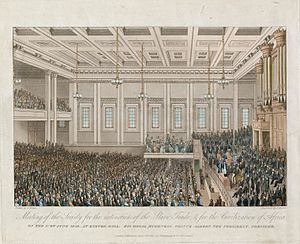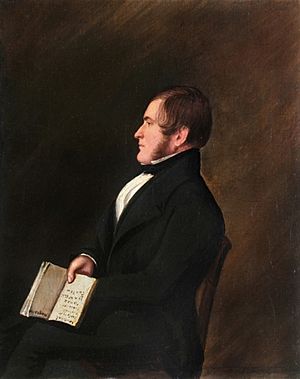Niger expedition of 1841 facts for kids
The Niger expedition of 1841 was a journey made by British groups between 1841 and 1842. They used three steam-powered ships to travel to Lokoja in what is now Nigeria. Lokoja is where the Niger River and Benue River meet. The British government supported this trip. Their goals were to sign agreements with local people, share the Christian faith, and encourage more trade. Sadly, many of the European sailors on the ships became very sick and died from diseases.
Contents
Planning the Niger Expedition: A Big Meeting

The idea for this expedition started at a large public meeting on June 1, 1840. This meeting took place at Exeter Hall in London. Prince Albert, the husband of Queen Victoria, was in charge of the meeting.
The main group behind the expedition was the Society for the Extinction of the Slave Trade and for the Civilization of Africa. Thomas Fowell Buxton started this group in 1839. Buxton had a big plan called "New Africa." He wanted to stop the slave trade in West Africa. His plan involved signing treaties with local leaders. He also hoped to introduce Christianity and boost trade. He wrote about these ideas in a book.
About 4,000 people attended the meeting. Important figures like Sir Robert Peel spoke. Prince Albert became the President of the Society. Even though the government at the time was not fully supportive, they did help pay for the expedition. For example, Lord Palmerston, who was in charge of foreign affairs, found money to offer Spain. This money was for an island called Fernando Po (now Bioko). This island was already used by British naval ships.
The Expedition's Journey
This journey was officially called the African Colonization Expedition. Some people, like Robert Jamieson, were against it. Doctors on the trip prepared for illnesses. They carried quinine, a medicine used to prevent malaria. The ships also had a special air system to keep them well-ventilated.
The Expedition Ships
Three steam-powered ships were built for the expedition. Their names were the Albert, the Wilberforce, and the Soudan. They were made by a company called Laird in Liverpool. Henry Dundas Trotter commanded the Albert. William Allen was in charge of the Wilberforce. Bird Allen commanded the Soudan.
The expedition stopped in Sierra Leone to pick up interpreters. Later, they visited Cape Coast in July. There, they dropped off two Ghanaian princes, Nkwantabisa and Owusu-Ansa. These princes had been living in England since 1836.
Achievements and Challenges
The expedition successfully signed treaties against the slave trade. These agreements were made in Aboh with Obi Ossai and in Idah. Commander Trotter in the Albert reached a place called Eggan. He was on his way to Raba when he became very ill and had to turn back.
The group also bought land at Lokoja. This spot is where the Niger and Benue rivers meet. Their plan was to build a center there for missionary work and trade.
However, the expedition faced a big challenge. Out of 150 Europeans on the trip, 42 died quickly. There were 130 cases of fever. People of African descent on the expedition did not die from these illnesses. Because so many people were getting sick, the naval commanders decided to stop the expedition. They went back to the island of Fernando Po. Other records show that 55 out of 159 Europeans died before the ships returned to England in 1842.
Key People on the Expedition
Many people took part in this important journey:
- Samuel Ajayi Crowther: He wrote a book about the expedition in 1842.
- John Duncan: He was a master-at-arms on the ship Albert.
- Edmund Gardiner Fishbourne: A naval officer on the expedition.
- Louis Fraser: He was also part of the crew.
- James Ormiston McWilliam: He was the chief surgeon on the Albert. When many others fell ill, he and the geologist Dr. William Stanger had to take over handling the ship. He wrote a book about the medical history of the expedition in 1843.
- James Schön: A missionary and linguist who also wrote a book about the expedition in 1842.
- Thomas Richard Heywood Thomson: He wrote a book about the expedition with William Allen in 1848.
- Theodor Vogel: He was the main naturalist, studying plants and animals. He sadly died in December 1841. His notes were used in a book about the plants of the Niger region. His assistant, John Ansell, found a special orchid on Fernando Po. This orchid was later named Ansellia africana after him.
What Happened Next
The famous writer Charles Dickens wrote about this expedition. He included a character named Mrs. Jellyby in his book Bleak House who was inspired by the expedition.
A group of Baptist missionaries were waiting on Fernando Po to meet the expedition. However, the meeting never happened. They stayed on the island and continued their missionary work there.



